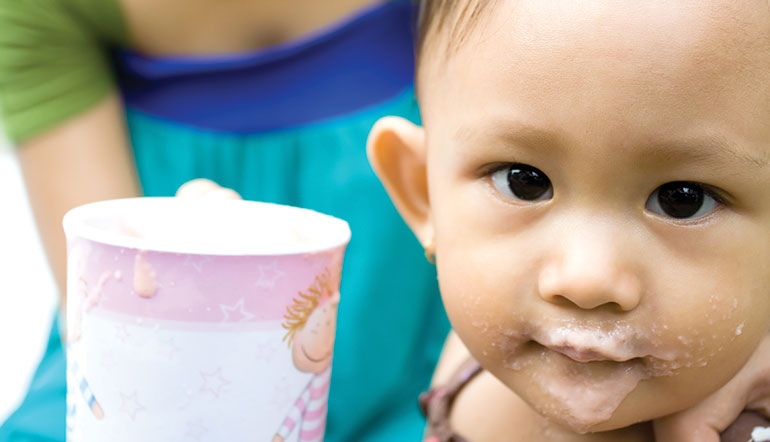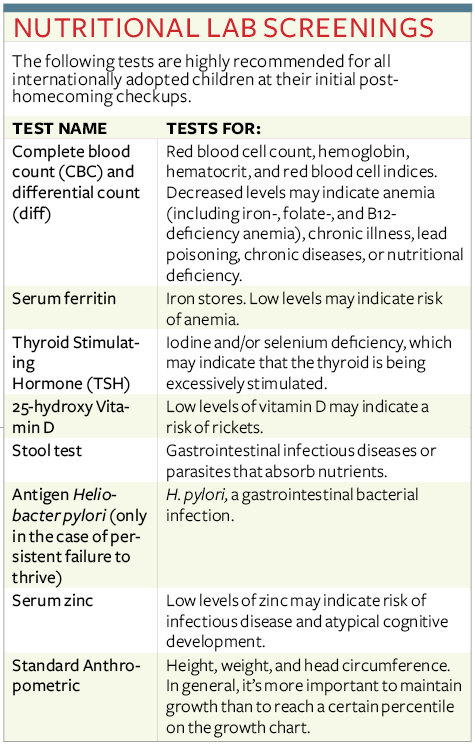When Cindy Kaplan adopted her son, Jadyn, from Kazakhstan, she didn’t know how profoundly her life would be impacted by her child’s early malnutrition.
When Jadyn came home, he was deemed a “failure to thrive”—an imprecise medical term applied when a child’s weight or weight gain is “significantly” below that of children of the same sex and age. At eight months old, Jadyn weighed just 11 pounds and was not strong enough to lift his head. He had endured two prolonged bouts of pneumonia in his first six months, which left him weak and severely delayed. Kaplan found herself entering motherhood under great pressure to pack pounds onto a dangerously malnourished baby.
As Kaplan learned, it is critical for adopting parents to assess the well-being of their new child. A child may be severely delayed in growth, like Jadyn, or he may appear to be healthy, but be deficient in nutrients needed for future growth and development. Once you know what to look for, there are many steps you can take, pre- and post-adoption, to improve your child’s growth curve after adopting a malnourished child.
Pre-Adoption Assessment
Before you adopt, learn as much as you can about your new child’s health and eating habits. Talk to his caretakers and, if possible, observe a mealtime while on your adoption trip or a pre-placement visit to his foster home. Pay attention to details, such as:
- Does he drink from a cup or from a bottle?
- Is he drinking formula or cow’s milk?
- How are the foods prepared?
- What is the consistency? Liquid? Purée? Soft chunk?
- Can he feed himself? If so, how does he handle utensils?
- Does he seem to have a favorite food? Any he strongly dislikes?
It is also important to ask about feeding schedules—how many times a day your child eats and when meals are served. If you’re adopting a child older than six months, chances are, he’s eating some solids. Ask what foods he’s been introduced to, and whether any have caused negative reactions. Answers to these questions will not only tell you about your child’s relationship with food, they’ll help you ease his transition to his new home.
Post-Adoption Evaluation
It is a good idea to conduct laboratory tests for mineral and vitamin levels to establish a baseline. If you found an adoption medicine specialist to evaluate your child’s referral, book an appointment with her within two or three weeks of your child’s homecoming. If the pediatrician you selected is not an adoption specialist, you may have to request these tests by name, as he may not know to order them. [For a complete list of tests recommended for internationally adopted children, see “Nutritional Lab Screenings.”]
Most pediatricians can conduct all of these tests, however, and should be able to draw enough blood in a single visit. At that first post-adoption checkup, you should also discuss any signs of malnourishment that you’ve noticed or should watch for: small stature or extreme leanness, poor posture, lack of strength, and so on.
Many of the tests will have to be repeated about six months later, even if the initial results were normal. Once he is home in a nurturing family, with plentiful food—and a parent’s love—it’s common for an adopted child to have a dramatic growth spurt, gaining inches and pounds at an incredible rate. However, such a period of accelerated growth will call heavily upon his body’s already meager nutritional reserves, and can result in anemia or another condition.
Boosting Calories
Kaplan took Jadyn to nutritionists and feeding experts who did not have experience with adoption, and she quickly became frustrated. The standard approach for a malnourished infant is to feed a high-calorie formula, and continue it past the typical cut-off age of one year, if necessary, but Jadyn rejected bottle-feeding and most liquids. So, Kaplan turned to books and online adoption chat rooms and trained herself in the techniques and diet tricks that would nourish Jadyn out of the danger zone.
What worked? Puréeing avocado with yogurt and fruits, and mixing concentrated formula into Jadyn’s rice cereal. As soon as Jadyn was old enough, Kaplan mashed nut butter into his fruits, along with other healthy oils. When Jadyn got into finger foods, Kaplan found the highest-calorie teething biscuits.
One of Jadyn’s favorite first solids were kalamata olives! Kaplan learned that children like Jadyn, who have sensory problems and/or low muscle tone, often like high-flavor foods. With the addition of soy sauce or salsa, other foods he had previously refused became big hits.
This article is the first in a two-part series. Read the second article, to learn about introducing new foods, regulating meal schedules and portions, and addressing feeding challenges in a newly adopted child.
Adoption Agencies
[businessdirectory-listings category=10910]
JOIN You are viewing this exclusive AF content as a guest. To access our full Adoption Parenting Library — plus digital issues, eBooks, expert audio and more — join Adoptive Families today.  |




